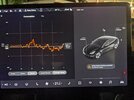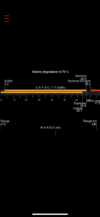Hello. I have a 2020 M3 Performance that was rated with 299 range. After a software update a couple months after buying it (Maybe around July or August 2020) the max range decreased to 277. Now it's at about 271. I feel like something is wrong here only having it less than a year with 23k miles on it.
I watched it decrease to 277 right after completing an update. Unfortunately, I didn't record the version or anything as I was a new Tesla owner.
I watched it decrease to 277 right after completing an update. Unfortunately, I didn't record the version or anything as I was a new Tesla owner.




